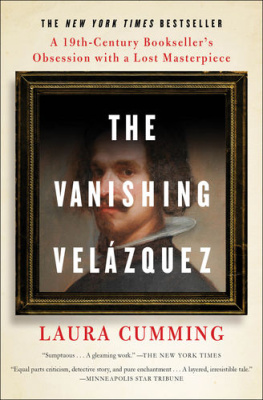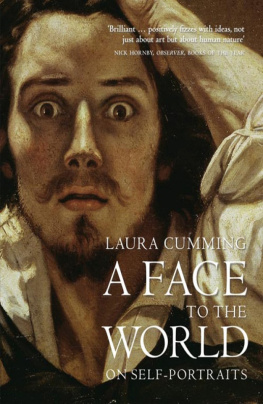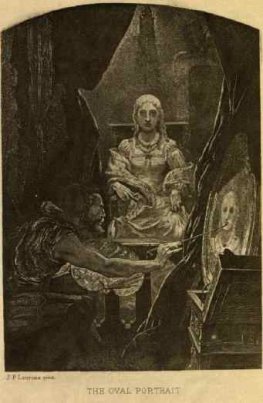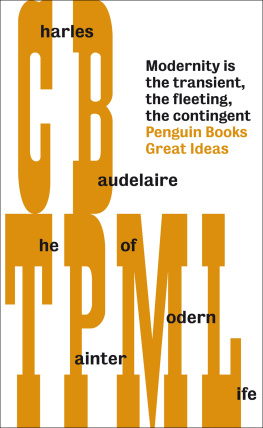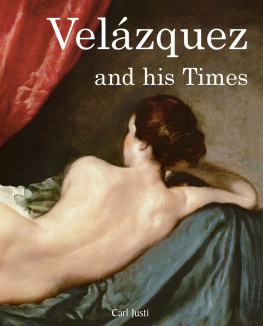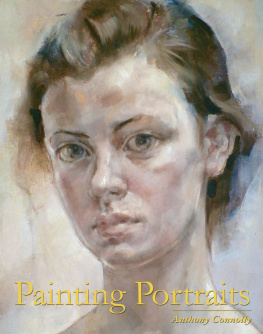Thank you for downloading this Scribner eBook.
Join our mailing list and get updates on new releases, deals, bonus content and other great books from Scribner and Simon & Schuster.
C LICK H ERE T O S IGN U P
or visit us online to sign up at
eBookNews.SimonandSchuster.com
ALSO BY LAURA CUMMING
A Face to the World: On Self-Portraits
Contents
For Hilla, Thea, Elizabeth and Dennis with all my heart And in memory of the painter James Cumming
1
A Discovery
M Y FATHER DIED quite suddenly when I was in my late twenties. He was a painter. The fatal illness attacked his brain, then his eyes. In my raging grief, I could not bear to look at any paintings but his, as a way of holding the memory of him as close and tight as possible, I suppose, and in blind protest against the blighting of his life and art.
Several months passed. I went to Madrid in a bitter midwinter, a city chosen because neither he nor I had ever been there and I couldnt speak the language. There would be no old associations and no new conversations; time could stand still while I thought about nothing and no one but him. Every day I would leave my hotel room and walk round and round the streets, spiraling out to the freezing suburbs and the snowcapped hills beyond. I did not know what else to do.
But Madrid is not large; I would pass the Prado Museum time and again, sometimes twice in one day, steeling myself not to go in. Eventually the effort to avoid the place became a distraction in itself and it was there, in that crowded city within a city, that I had the luckiest of strikes. On a hunt for El Greco, one of my fathers favorite painters, I was passing the opening to a large gallery when a strange frisson of light caught the edge of my eye. As I turned to look, all the people standing at the other end of the gallery suddenly moved aside as one, clearing an open view to the source of that light: Velzquezs monumental Las Meninas . I had no thought of it, no idea it would be there or how vast it would bean image the size of life, and fully as profound. The living people revealed the painted people behind them like actors in the same performance, and flashing up before me was the mirror-bright vision of a little princess, her young maidservants and the artist himself, all gathered in a pool of sunlight at the bottom of a great volume of shadow, an impending darkness that instantly sets the tenor of the scene. The moment you set eyes on them, you know that these beautiful children will die, that they are already dead and gone, and yet they live in the here and now of this moment, brief and bright as fireflies beneath the sepulchral gloom. And what keeps them here, what keeps them alive, or so the artist implies, is not just the painting but you .
You are here, you have appeared: that is the split-second revelation in their eyes, all these people looking back at you from their side of the room. The princess in her shimmering dress, the maids in their ribbons and bows, the tiny page and the tall, dark painter, the nun whose murmur is just fading away and the chamberlain silhouetted in the glowing doorway at the back: everyone registers your presence. They were here like guests at a surprise party waiting for your arrival and now you have entered the room their room, not the real one around youor so it mysteriously seems. The whole scene twinkles with expectation. That is the first sensation on the threshold of that gallery in the Prado where Las Meninas hangs: that you have walked into their world and become suddenly as present to them as they are to you.
The image holds you there, stopped in surprise, motionless as the moment it represents in which all these people pause too, except the little page nudging the stoic dog. Everything is still except for the circumambient air and the light fluttering across the white-blond hair of the princess, who stares at you with the candid curiosity of a child at the center of a painting that is itself so completely attentive. The dwarf gives you her frank consideration, hand on heart, the maids kneel or curtsy, the servants observe you, all the way to the man in black hovering on the threshold of this room, waiting to usher you into the next. And from behind the back of the great canvas on which he is working, the size of this one, steps the painter himself, taciturn, watchful, the magician momentarily revealed.
But take a few steps towards this painting in all its astounding veracity and the vision swithers. The princesss lustrous hair begins to look like a mirage, or a heatwave scintillating above a summer road that vanishes at your approach. The face of the lady dwarf dissolves into illegible brushstrokes. The figures in the background become inchoate at point-blank range and you can no longer see where a hand stops and the tray it is holding begins. The nearer you get to the painting, the more these semblances of reality start to disappear, to the point where it is impossible to fathom how the image could have been made in the first place. Everything is on the verge of dissolution and yet so vividly present that the sunshine in the painting seems to float free and drift out into the gallery. It is the most spellbinding vision in art.
Las Meninas The Maidservants was most likely painted in 1656, four years before Velzquezs own sudden death (scene is fulfilled by you. Velzquez invents a new kind of art: the painting as living theater, a performance that extends out into our world and gives a part to each and every one of us, embracing every single viewer. For anyone who stands before Las Meninas now, held fast by the eyes of these lost children and servants, is positioned exactly where the people of the past once stood. This is part of the pictures content. It elects you to the company of all who have ever seen it, from the little princess and her maids, who must have rushed around to see themselves the moment Velzquez finished, to the king and queen who appear in miniature in that glimmering mirror at the back. We stand where they once stood, the mirror implies (and the servants eyes), looking into this scene, this moment held intact down the centuries. The picture turns the world upside down, so that citizens may take the place of kings, and kings may be tiny compared to children. We stand together in history and Las Meninas gathers us all into its boundless democracy.
The painting I saw that day seems to hold death back from the brink even as it acknowledges our shared human fate. It shows the past in all its mortal beauty, but it also looks forward into the flowing future. Because of Velzquez, these long-lost people will always be there at the heart of the Prado, always waiting for us to arrive; they will never go away, as long as we are there to hold them in sight. Las Meninas is like a chamber of the mind, a place where the dead will never die. The gratitude I feel to Velzquez for this greatest of paintings is untold; he gave me the consolation to return to my own life.
We see paintings in time and place (no picture makes this clearer, putting us on the spot and in the moment) and always in the context of our own lives. We cannot see them otherwise, no matter how objective we might hope to be. Novelists long ago recognized this truth; literature is full of characters falling in love with the people in paintings, obsessing over enigmatic figures or shapes, feeling intimidatedor intensely disappointed, in the case of Madame Bovaryby their first sighting of a tarry Old Master. Fictional people are allowed to have feelings about art entirely unconnected with the analysis of formal attributes, still less any knowledge of art history. But this is not how the rest of us are encouraged to view art by specialists and historians, for whom feelings may be dubious, unstable or irrelevant. If one should happen to experience an involuntary personal response, an eminent art historian once advised me, as if mentioning some embarrassing arousal, one should always keep it firmly to oneself.
Next page

